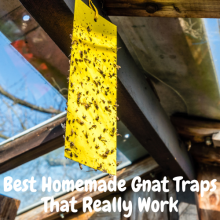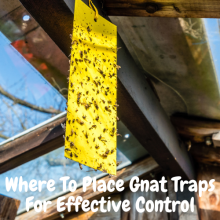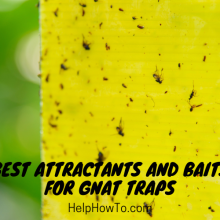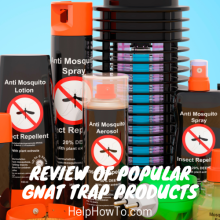Do Bug Zappers Kill Gnats Effectively? – The Answer Here | HelpHowTo
Summary of Answering Do Bug Zappers Kill Gnats Effectively
Bug zappers can effectively kill large numbers of gnats when used strategically, but have limitations in fully eliminating infestations. Key to their performance is using UV bulb models that emit light in the 350-450nm range most attractive to fungus gnats and fruit flies, properly placing zappers near gnat breeding sites while avoiding competing lights, and combining zappers with efforts to remove gnat food/moisture sources.
Even basic zappers can kill hundreds or thousands of gnats per night with the right bulbs and placement. However, they only target adult gnats, have a limited range, indiscriminately kill beneficial insects, create unsightly debris, and require regular cleaning and maintenance. When integrated into a comprehensive pest management approach with realistic expectations for temporary control rather than complete eradication, UV bug zappers can provide satisfying visible reductions in nuisance gnat populations around homes and patios.

Our Top 5 Recommended Indoor Genat Traps
Sick of pesky gnats invading your home? Discover the top 5 indoor gnat traps to banish these annoying insects for good! Our expert reviews reveal the most effective, easy-to-use traps. From powerful UV attractants to eco-friendly vinegar traps, we’ve thoroughly tested and ranked the best solutions. Check Now

Do Bug Zappers Really Kill Gnats Effectively? An In-Depth Look
For homeowners plagued by clouds of tiny, swarming gnats, bug zappers can seem like an attractive solution. With their promise to lure and instantly zap flying insect pests, these electric insect killers are widely available and seemingly offer an easy way to control gnat problems. But just how well do they actually perform against these persistent pests?
The Basics of Bug Zappers
Bug zappers operate by using artificial lights to attract insects like gnats, moths, flies and mosquitoes. Once drawn toward the device, the unlucky bugs make contact with an electrified metal grid or high-intensity bulb that zaps them with a fatal jolt of electricity.
Models range from basic plug-in units for indoor use to solar-powered or rechargeable zappers designed for outdoor placement. More advanced models may feature ultraviolet bulbs, octenol lures to better attract mosquitoes, and collection trays to capture zapped insects.
Do Gnats Actually Get Zapped?
One of the key factors determining a zapper’s effectiveness on gnats is whether the emitted light wavelengths match those most attractive to gnats. Many gnats, especially fungus gnats and fruit flies, are drawn to ultraviolet and blue-violet light in the 350-450 nanometer range as they search for decaying organic matter to feed on.
Zappers using traditional incandescent bulbs may struggle to lure gnats, while those equipped with UV or black light bulbs could prove far more enticing. The intensity of light output also plays a role, with brighter zappers better able to compete with ambient lighting and attract gnats from further away.
Placement is Critical
Positioning also greatly impacts a bug zapper’s performance against gnats. For best results, they should be placed near gnat breeding sources like overwatered potted plants, compost piles, or areas with spilled sugary residue.
Zappers work optimally when placed 6-8 feet off the ground, hung over gnat hot spots rather than placed flush against walls, and located away from competing light sources like bright porch lights that could overwhelm the zapper’s attractive glow.
How Effectively Do Zappers Kill Gnats?
When placed properly near gnat-infested areas using the right bulbs, studies show that even basic zappers can kill hundreds to thousands of gnats over the course of a warm summer night. More powerful models rated for stronger voltages and coverage areas unsurprisingly tend to rack up higher kill counts.
However, experts caution that zappers alone typically won’t eliminate persistent gnat infestations since they only kill adult flies and leave eggs/larvae to replenish the population. Combining zappers with efforts to eliminate gnat breeding habitats and moisture sources yields best results.
Some models offer additional gnat-specific features like cylindrical trapping designs or adhesive surfaces designed to boost sticky capture rates. But most basic zappers excel at eliminating nuisance adult flies more than totally clearing infestations.
Potential Downsides
While undoubtedly effective at killing gnats to some degree, bug zappers do have notable drawbacks to consider:
Limited Range – Most zappers only have an attractive radius of 25-30 feet, limiting coverage for larger yards.
Catch Non-Targets – Zappers indiscriminately kill all sorts of insects, including beneficial pollinators, predatory bugs and other non-pests.
Fire Hazard – If placed near dry vegetation, accumulated zapped insects can pose a fire risk on the electrified zapper grids.
Unsightly Debris – Shockingly effective zappers end up with piles of sizzled insect remains that need regular cleaning.
UV Exposure – Some UV zappers carry a minor health risk with ultraviolet light exposure over an extended period.
Noise and Pet Safety – Live electric grids produce an audible zapping noise that can disturb some and pose a minor shock hazard to curious pets or children.
Given these potential issues, zappers may not be ideal for everyone. But when used responsibly and strategically, they can provide satisfying gnat control, especially for severe infestations where visible results are desirable.
The Bottom Line on Gnat Zappers
When used in a comprehensive pest management plan, ultraviolet bug zappers can undoubtedly kill large numbers of gnats congregating around homes and patios. Their effectiveness depends heavily on:
- Placing them near gnat breeding sources with minimal competing lights
- Using UV bulb models that emit peak wavelengths for gnat attraction
- Combining zappers with efforts to eliminate sources of excess moisture
- Realistic expectations about total population elimination and catch limits
While noisy, unsightly, hazardous to some beneficial insects, and requiring hands-on seasonal maintenance, zappers provide gratifying visible results for those willing to invest time properly deploying them as part of an integrated pest solution.
With strategic placement using the ideal bulb type, homeowners plagued by fungus gnats, fruit flies and other nuisance gnat species can count on these electrified insect assassins to create temporary relief from suffocating swarms. Just be sure to address root causes, because zappers provide control but not lasting extermination.

Our Top 5 Recommended Indoor Genat Traps
Sick of pesky gnats invading your home? Discover the top 5 indoor gnat traps to banish these annoying insects for good! Our expert reviews reveal the most effective, easy-to-use traps. From powerful UV attractants to eco-friendly vinegar traps, we’ve thoroughly tested and ranked the best solutions. Check Now
FAQs and Answers
Do bug zappers work better indoors or outdoors for killing gnats?
Bug zappers tend to work better outdoors for killing gnats, especially fruit flies and outdoor gnat species. Here’s a bit more detail:
Indoors:
- Bug zappers can help control indoor fungus gnat populations that arise from overwatered houseplants or moisture issues.
- However, they have a limited range and may struggle in larger homes if not placed near the gnat breeding sources.
- Zappers create unsightly piles of zapped insect debris that need cleaning up indoors.
Outdoors:
- Zappers are more effective against outdoor fruit flies, phorid flies, and other gnat species attracted to things like compost piles or rotting vegetation.
- They can be positioned near prime outdoor gnat breeding sites with fewer indoor lighting competitors.
- Outdoor models can cover larger areas and benefit from better airflow attracting gnats to the zapper.
- Debris from zapped gnats is less of an indoor mess outdoors.
So while indoor use is possible, zappers are generally better suited for outdoor environments when specifically targeting gnat control. Their wider coverage, targeted outdoor placement options, and lack of indoor debris make them perform better against outdoor gnat infestations.
How does the size or coverage area of a bug zapper impact its effectiveness on gnats?
The size and rated coverage area of a bug zapper can significantly impact its effectiveness in killing gnats. Larger, more powerful zappers tend to outperform smaller units when it comes to attracting and eliminating gnats.
Here are some of the key ways that zapper size and coverage area relate to gnat-killing ability:
Light Output
Bigger zappers utilize more intense ultraviolet bulbs or have more bulbs, producing a brighter light output that can attract gnats from further distances – often 1/2 acre or more for the largest units.
Electrified Grid Size
Models with larger electrified grids or killing surfaces provide more area for gnats to make fatal contact once lured closer by the light source.
Voltage Power
Higher voltage zappers (3000V+) kill insects more effectively upon contact compared to lower voltage models under 1000V. Large area units pack more voltage punch.
Bulb Coverage Pattern
Some zapper bulbs are designed to project light up and outward in broader coverage patterns that can better illuminate gnat-infested areas.
Simply put, a small 1/4 acre zapper just can’t compete with the attractive brilliance and killing power of a premium 1 acre+ rated zapper when it comes to eliminating clouds of swarming gnats in larger outdoor areas.
However, smaller corded units may be preferable for targeted indoor gnat issues when using outdoors isn’t practical. But for major outdoor gnat infestations, investing in a beefy high-voltage large-area zapper will yield much higher gnat reductions.
So while niche uses exist, most experts recommend opting for the largest, highest voltage zapper rated for your outdoor area’s square footage when trying to maximize overall outdoor gnat elimination performance.
Are bug zappers safe to use around children and pets when trying to eliminate gnats?
Bug zappers do pose some potential safety risks around children and pets that need to be considered when using them for gnat control:
Electrocution Hazard
The electrified grids or high-intensity bulbs that zap insects can deliver a painful shock if touched by little fingers or noses. This shock could potentially cause burns, especially on higher voltage zappers.
Fire Hazard
Over time, piles of zapped insect debris can accumulate in the zapper’s catch tray or on the grill, creating a potential fire hazard if left uncleaned, particularly around dry vegetation.
UV Light Exposure
Some zappers use ultraviolet bulbs that can cause eye strain and potentially skin irritation with extended exposure at close proximity.
Noise Disturbance
The constant zapping of insects can produce an audible buzzing or snapping noise that some children and pets may find disturbing or startling.
While most models feature safety guards and warnings, the best practice is keeping zappers well out of reach and monitored when in use around kids or pets. Some “pet safe” models enclose grids behind closable tents or domes.
If using around homes with children or roaming pets, it’s advisable to:
- Use low-voltage cordless models (<1500V)
- Keep zappers several feet off the ground
- Empty catch trays frequently
- Consider models with enclosed killing grids
- Limit exposure times for kids/pets nearby
Proper supervision and keeping zapper use restricted to low-risk areas provides a reasonably safe way to kill gnats without endangering children or furry friends. But complete avoidance is wise with very young kids who may attempt contact.
Do bug zappers that use attractant lures work better than light-only models for gnat control?
Yes, bug zappers that combine ultraviolet light with additional chemical lures or attractants can be more effective than light-only models when it comes to controlling gnat populations.
Most standard zappers rely solely on the UV light to lure in flying insects like gnats. However, gnats can be attracted to specific scents and chemicals produced by the organic materials they feed on.
Some zappers take advantage of this by incorporating lure cartridges or packets containing things like:
Octenol
This chemical mimics the scent produced by human breath and sweat, making it very attractive to biting gnats and mosquitoes.
Carbon Dioxide
Emitting low levels of CO2 can simulate the exhalations of mammals and birds that draw in gnats looking for food sources.
Phenol Lures
These replicate the smells produced by decaying organic matter like rotting fruits that fungus gnats and fruit flies seek out.
Combining UV light with pheromone attractants like these creates a multi-faceted lure that can increase gnat catch rates significantly over light alone for certain species.
In one study, traps using octenol and UV light caught over 20 times more biting gnats than light-only traps. Other research shows similar boosts when using phenol lures for fungus gnats.
So while straight UV zappers can attract and kill many gnats through light alone, models using supplemental attractant lures leverage additional gnat enticements beyond just light for potentially much higher levels of control over infestations.
The tradeoff is that attractant cartridges need periodically replacing and some lures may be more insect-specific. But for severe gnat problems, the added investment can be well worth the boost in elimination power.
How do the costs of buying and operating bug zappers compare to other gnat control methods?
The costs of buying and operating bug zappers can vary quite a bit compared to other gnat control methods. Here’s a general cost comparison:
Initial Purchase Cost:
Bug Zappers – $20 to $150+ depending on size/features
Gnat Traps – $5 to $30 per pack
Insecticide Sprays – $5 to $20 per bottle
Operating/Recurring Costs:
Zappers – Electricity usage (modest), bulb replacements ($5-$20)
Traps – Must continually replace used traps ($10-$30 per month)
Sprays – Continual reapplication needed ($10-$30 per month)
Professional Pest Control:
Bringing in an exterminator for perimeter spraying can cost $100-$300 per treatment needed.
So while basic zappers have a higher upfront cost than DIY traps or sprays, their operating expenses are relatively low if the bulbs don’t need frequent replacement.
More premium zappers in the $100+ range have higher purchase prices but also tend to be more effective and longer-lasting, potentially making up for the cost over time versus continually buying disposable gnat traps.
For severe infestations, hiring an exterminator can become costlier than a one-time zapper investment if repeat treatments are needed. Though combining professional spraying with zappers may provide the best overall control.
Ultimately, upfront zapper costs are higher than basic retail products but their relatively low operating costs over months/years of use can make them cheaper long-term for moderate-to-severe gnat issues when factoring in retreatment costs of other methods.
Their main value comes from the convenience and visible “zapping” performance compared to less dramatic baits or sprays. So for those willing to make the equipment investment, they can pay off in cost-effectiveness and satisfaction if properly deployed.

Our Top 5 Recommended Indoor Genat Traps
Sick of pesky gnats invading your home? Discover the top 5 indoor gnat traps to banish these annoying insects for good! Our expert reviews reveal the most effective, easy-to-use traps. From powerful UV attractants to eco-friendly vinegar traps, we’ve thoroughly tested and ranked the best solutions. Check Now





